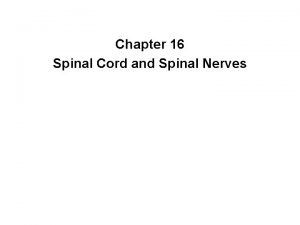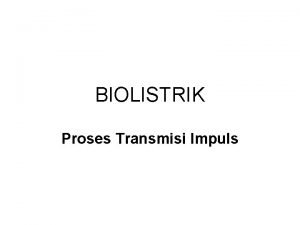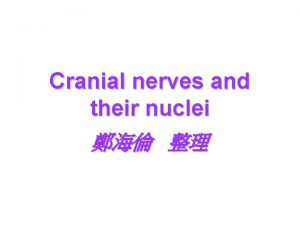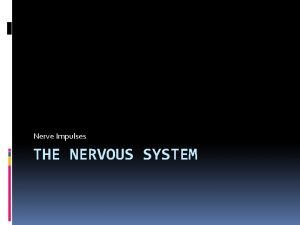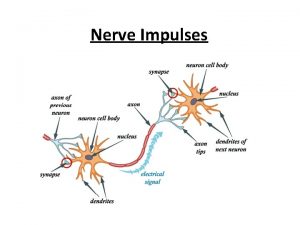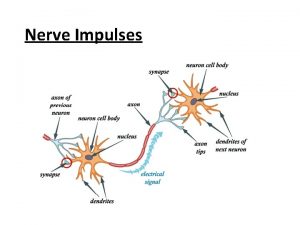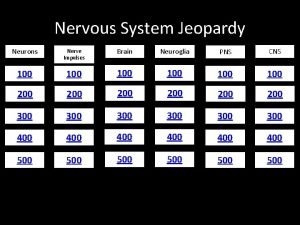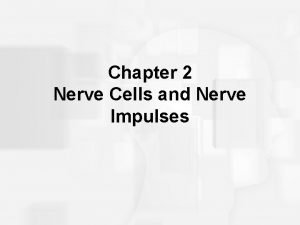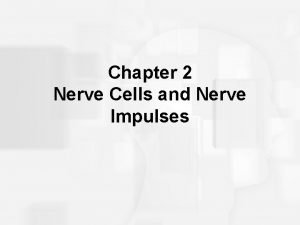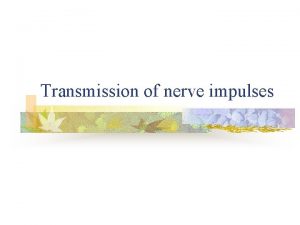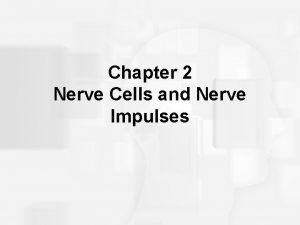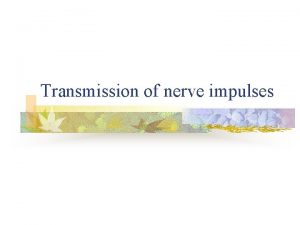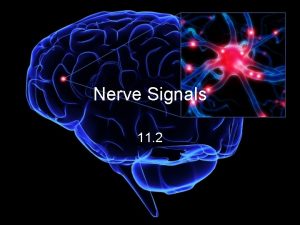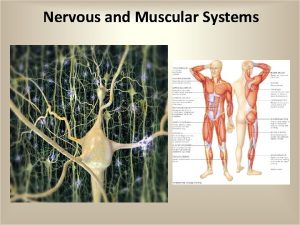NERVOUS SYSTEM Nerve Impulses PHYSIOLOGY NERVE IMPULSES Two
















- Slides: 16

NERVOUS SYSTEM Nerve Impulses

PHYSIOLOGY: NERVE IMPULSES Two major functional properties: • Irritability – ability to respond to a stimulus and convert it into a nerve impulse • Conductivity – ability to transmit the impulse to other neurons, muscles, or glands.

POLARIZATION A resting or inactive neuron is considered to be polarized. Polarization results from the fact that there is an uneven distribution of ions (charged particles) on either side of the membrane. • There are fewer positive ions inside the neuron then outside. • The major positive ions inside the cell are potassium (K+) • The major positive ions outside the cell are sodium (Na+) • As long as the inside of the neuron remains more negative than the outside, the neuron will stay inactive.


DEPOLARIZATION Neurons respond to a stimulus by opening Na+ channels in the plasma membrane. Na+ normally can’t diffuse through the plasma membrane However, when the Na+ channels open Na+ can rush into the neuron through the process of diffusion. When this happens the inside of the neuron goes from being more negative to more positive changing the polarity of the cell.


Depolarization results in two types of polarity: Graded potential – change in polarity that will vary in degree depending on the strength of the stimulus. (Stronger the stimulus, the more positive the inside of the cell becomes) Action potential – change in polarity associated with the transmission of a longdistance signal. Occurs only on the axon of a neuron and is an all-or-none response.

REPOLARIZATION When the neuron returns to the original resting state from a depolarized state it is called repolarization. Repolarization occurs when Na+ channels close and K+ channels open. K+ rushes out of the cell causing the cell to become more positive on the outside and negative on the inside.



REFRACTORY PERIOD • The action potential has passed – signal was sent • The Na+ channels can’t open • This keeps the action potential from being able to travel in the wrong direction.

UNMYELINATED VS. MYELINATED ACTION POTENTIAL Myelinated cells – Conduct impulse faster because the signal jumps from node to node. Saltatory conduction – myelinated neurons conduction

CONDUCTION IMPAIRMENT Sedatives and anesthetics block nerve impulse by making the neuron impermeable to Na+. Cold and continuous pressure hinder impulse conduction because blood supply is cut off. No nutrients or oxygen for the neuron.

WHAT ABOUT CONDUCTIVITY

CROSSING THE SYNAPSE Synapse – Gap between the Axon terminal and the Dendrite 1. Action potential arrives at the axon terminal and opens calcium channels. 2. Calcium causes neurotransmitter chemicals to fuse with the axonal membrane and to be released. 3. The neurotransmitters diffuse across the synapse and bind to receptors on the membrane of the dendrites of the next neuron.

 Incoming sensory impulses and outgoing motor impulses
Incoming sensory impulses and outgoing motor impulses Transmits nerve impulses
Transmits nerve impulses Integration center
Integration center Label the different types of neuronal pools in the figure.
Label the different types of neuronal pools in the figure. Sensory input and motor output
Sensory input and motor output Neuronal processes
Neuronal processes Nerve muscle physiology
Nerve muscle physiology Social impulses foster infant language
Social impulses foster infant language Social impulses foster infant language
Social impulses foster infant language Biolistrik
Biolistrik Nervous system and digestive system
Nervous system and digestive system Endocrine system and nervous system
Endocrine system and nervous system Mechanism of hormone action
Mechanism of hormone action Endocrine system and nervous system
Endocrine system and nervous system Trigeminal nerve which cranial nerve
Trigeminal nerve which cranial nerve Anatomy and physiology unit 7 cardiovascular system
Anatomy and physiology unit 7 cardiovascular system Bronchial tree
Bronchial tree


